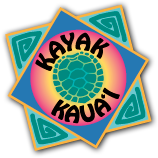Na Pali Coast | Back Pack Camping
Revised 12/3/2022
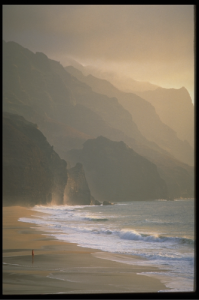
Kalalau Beach, Na Pali Coast
The following is not meant to be an exhaustive treatment of hiking the Na Pali Coast but a primer to get you going.
For a very readable and informative treatment of backpacking the Na Pali, we recommend Kathy Valier’s excellent book: On the Na Pali Coast-A Guide for Hikers and Boaters (which is out of print).
Of the recognized trails in Hawaii, the Na Pali coast trail is considered to be one of the roughest in all Hawaii.
Navigation is easy: going in, keep the cliffs on the left and the ocean on the right, and vice a versa upon your return. If at any moment in time you do not see the ocean or if you do not see the land….you may be lost.
DLNR: Kalalau Trail Visitor Safety Video
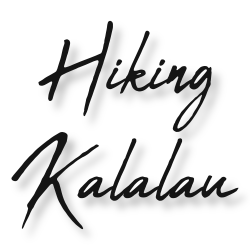
Here is a novel way to learn more about the Kalalau Trail. Get all your questions answered at hikingkalalau.com. They also have a great video course going into all the details about logistics, permits, gear, how to prepare, and what to expect.
Factoids:
- Trail starts: End of Highway #560 by Ke’e Lagoon
- You have to walk via the board walk from the greeting area/parking lot within Ha’ena State Park.
- Trail ends: Kalalau Valley, by Kolea waterfall.
- Length: 6 miles as the crow flies and 11 miles as the worm crawls.
- Rating: Moderate to difficult.
- Hardest time of the year to get permits: June, July, August
- Minimum recommended stay: two nights Kalalau (3 days)
- Whale watching: November to early May
- Rainy season: All year
- Driest months: August/Sept
- Most crowded month: August
- Camping: allowed only with permit at Hanakoa and Kalalau
Trail Times:
- Ke’e to Hanakapi’ai Beach: 1.5 to 2 hours
- Ke’e to Hanakoa Valley: 3 to 4 hours
- Ke’e to Kalalau Valley: 6 to 8 hours
Classic Route
The classic approach to backpacking the Na Pali is to backpack to the half way point at Hanakoa Valley and decamp. This offers a welcome break for sore muscles and from a heavy pack. The next day, with a lighter pack, a couple of hours brings you to the saddle of Red Hill with the paradisaical view of Kalalau Valley.
Once at Kalalau, the recommended minimum is to spend at least one or two nights (2 nights Kalalau if hiking in all the way the first day), if not more.
Several days later with a seriously lighter pack, you can hike all the way out in one day or stop and camp again at Hanakoa.
The Na Pali Coast Trail
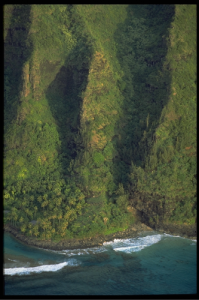
Kee Lagoon, Na Pali Coast
Ke’e Reef Lagoon
The trail-head officially begins by Ke’e lagoon, in Ha’ena State Park (not to be confused with Ha’ena COUNTY Park, which is East and a short drive (or even a short walk), and where you used to be able to camp and can now only day park.
There is no camping allowed in Ha’ena STATE Park and environs.
Since the Flood of April 2018
The floods afforded a moment for the State to integrate a master plan to address the deteriorating conditions by over use of the resource, especially at the Ke’e trail head.
NEW Limited overnight parking is now available in Haʻena State Park for campers with overnight permits for Nāpali Coast State Wilderness Park. Camping permits must be acquired from State Parks prior to purchasing overnight parking. These spots are available for purchase up to 90 days in advance and users will be charged for the number of days your vehicle occupies the lot (e.g. a one night stay will require paying for 2 days, a 4 night stay will require paying for 5 days, etc.).
Two Ways to access the trail:
In each instance make sure to have your camping permit handy to show the “gate keepers” at Ha’ena State Park.
- Take the North Shore Shuttle from Princeville Makai Golf Club or Waipa/Hanalei to Ha’ena State Park.
- No overnight parking in Waipa.
- * Princeville overnight parking: Customers need to arrange with Princeville Makai Golf Club (808) 826-1912 or Alii Kai 808-826-9988
- (The following service is presently not available)
- Another alternative is to overnight park at Kayak Kauai’s off premise private parking lot in Kapa’a and arrange for a custom shuttle. Call for more information and/or to book: (808) 826-9844
Hanakapi’ai Beach
There is a required day use permit from Ke’e to the beach, the falls of Hanakapi’ai.
Note: there are toilets that are on the SW side as you go into the interior of Hanakapi’ai Valley.
Highlights:
At the NE and SW end of the beach, especially during the summer, there can be some caves that are worth a crawl/walk under and around.
Dangers:
Pounding shore break! Hanakapi’ai beach is a popular destination for those wanting to drown. Surf, on most days of the year, is a pounding shore break made worse by a small cove ready to sweep you out to sea. If you do dare to swim, have a back up plan and be resigned to a long survival swim to the spacious and pounding shores of Kalalau. Recommend: avoid swimming in the sea, and instead take a bracing swim in the Hanakapi’ai stream.
Swollen streams! Without rain you would not have rainbows, or the flip side, flooding streams. If the Hanakapi’ai stream or any other stream along the coast is running swift and with a brown muddy color, it is a sign that the stream is trying to speak to you visually and a warning that it is in a flood stage. Good rule of thumb, don’t cross or wait until it subsides (which amazingly it can do in short time). If you hear boulders rolling under water, this is a clear sign that a crossing could be suicidal and that the stream is not only communicating but is screaming at you.
Hanakapi’ai Falls
Prior to hurricane Iniki, there was a loop trail up the valley to the waterfall of Hanakapi’ai. While this loop is no longer maintained, the easiest way to access the falls is the traditional route: cross the stream of Hanakapi’ai and work your way up the valley and away from the ocean. A 1.5 to 2 hour hike from the beach, will bring you to one of the nicest waterfalls in the entire park.
The Hanakapi’ai falls, rivals any found along the Na Pali Coast state park.
Highlights:
Myriad of stream crossing and pools are inviting areas to take a break and swim. At the beginning as you wander by the bamboo on the left, look for remnant structures of a former coffee plantation and coffee plants all around.
Dangers:
Floods are mentioned before. Fight the urge to swim under the actual Hanakapi’ai waterfall; if you persist, in spite of this wise council, it might be fun to count all the rocks/boulders that are strewn and gathered about you and try to guess when the next avalanche of rocks will be. Advise foregoing the thrill, and swim in the deep and classic pools just before the approach to the terminus of the fall.
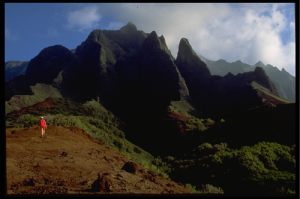
Descending Red Hill into Kalalau Valley
Hanakoa Valley
Is open to day use and camping. Beyond Hanakoa and you need a camping permit.
Perched on a small cliff and cove, Hanakoa Valley is more or less the half way point on the trail. Hanakoa has been traditionally the favored mid-point to stop for camping and to recharge one’s “battery”.
Highlight: Short walk to Hanakoa Falls.
Dangers: Observe same flood advice, mentioned above.
Kalalau Valley
From Hanakoa Valley you will generally be leaving the wetter pig country side and entering the more arid goat country
Between Hanakoa and Kalalau there is one small stretch of exposed trail, i.e. called “Crawlers Ledge”, that has always proved challenging for those who have height issues, like vertigo. It is considered the crux of the trail.
Once you reach the saddle above Red Hill, it is worth stop before descending, to gaze down below and around the valley of Kalalau to admire its wafer thin fluted ridges. Follow the trail down Red Hill, cross the Kalalau stream; parallel the boulder strewn beach, camp spots, ranger buildings, toilets to where the trail arbitrarily ends at Kolea Falls.
Camp spots are harder to find the closer you are to the waterfall. Camp by the waterfall and you are risking being near rock falls.
During the summer , when the surf allows, you can camp in the sea caves past the waterfall; when this is possible and if you care to sleep on the beach, you can often dispense with a tent/mosquito net (bugs are more problematic when you camp back in the foliage). If it rains, you can tarp it or retreat to the caves which are fairly dry except for a “post nasal” drip pitter patter which can be minimal to the deluge outside.
Highlights:
- Hike up valley to Davis Falls or Big Pool
- Taking your clothes off
- Putting your clothes back on because you discover the true utility of clothing in protecting you from the blistering sun.
- Hike/swim to the next cove of Honopu (recommended only for those who are at home in our rough Hawaiian waters and only during the “calmer” summer)
Dangers:
Usually big and pounding surf and offshore currents and rips scour the shores of Kalalau. Swimming to the beach of Honopu, if you are not a seasoned swimmer familiar with Hawaiian waters, is not a good idea. Look for falling rocks between the beach and the sea caves that look like small meteorites in soft sand. Note all the falling rocks that festoon and garland the beach below the cliffs fronting the caves. Your head could be the impact zone for those homegrown meteorites. Climbing off the trail is always risky. Rocks in Hawaii are notoriously rotten and thus it is not advisable to depend on them as a hand or foot hold. Hiking out of Kalalau, the old fashioned way, by going up the cliffs in the back of the valley is never a good idea.
The Minimalist Backpacker

Kalalau Beach
In the spirit of backpacking and making items serve dual and even triple purpose, below is a list that a monk would envy. Some items that can clothe you, could also serve as a thermal layer in you sleeping arrangement. (Those items have an * asterisk by them).
Minimalist Na Pali Uniform (from head to toe)
- Hat
- *Skull cap (your ace for sleeping at night or if the weather turns glacial)
- Sunglasses
- Rain gear (waterproof jacket or poncho)
- *Light sweater or fleece jacket
- T-shirt
- *Long sleeve shirt
- Shorts and/or bathing suit
- *Long loose pants
- Shoes:
– Light hiking boots
– Athletic sandals
– Tennis shoes
– Tabis (local favorite with felt sole and cloven toe) - *Socks
Minimalist Sleeping Gear
Leave your three season bag at home or bring the liner from your winter expeditionary sleeping bag and sleep with the layers that are provided by your spare clothes (see asterisks above):
- Light fleece blanket
- Sleeping pad
Frame vs. Internal Packs
The controversy doesn’t really matter. Frame packs are a little cooler and the trails are generally well groomed where a frame pack does not snag. On the same vein, while a internal frame pack, is generally a little hotter to carry, it does lend itself well to sending as baggage when flying over.
|
||
|
Stove
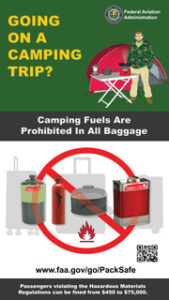
![]()
In Alaska, a stove is life promoting. Here in the tropics a stove is nice, especially if a hot cup of coffee is as life promoting as a hot meal in Alaska.
Since 9/11, the authorities at TSA have been confiscating stoves and fuel bottles even when empty of all fuel. The confiscations seem to happen in an arbitrary manner. Carrying fuel on the airline, of any kind, has always been prohibited.
Also Isopro/butane and/or propane canisters are prohibited.
To avoid the risk you can rent stove and buy fuel from KK (see link below).
On a tangent, what is appreciated along the coast, and what is what is referred to as “Kalalau diamonds”, i.e. cold sparkling ice!
Tent
A lightweight tent is especially nice for the rains and for the bugs. A tent also provides another thermal layer when sleeping. If you camp at Hanakoa, a good tent will keep the rain and bugs away. At Kalalau, which is more on the dry side, you have options, especially during the summer when the ocean recedes and leaves the caves open, for camping without a tent. In winter these same caves are being battered by waves. If it rains, and you are caught without a tent you can scurry to the caves. If you want to further avoid bugs when at Kalalau, avoid camping by the vegetation line and camp on the beach.
For the creative minimalist, one answer is to forgo the tent and just take a tarp, some line, and a mosquito net. A tarp is more multi-functional than a tent and lends itself to creative pursuits as for e.g.: sun bloc, water catchments, ground cover, etc.
Keeping Things Dry
One approach is to isolate food items and clothing articles in small bowling ball size parcels. These parcels can be “enveloped” in their individual vinyl stuff sacks that are lined first with a light weight plastic garbage bag. The idea is that the vinyl stuff sack protects the plastic bag from snagging and if you tied the plastic bags well, from leaking water in. Alternatively, if you are careful “trash compactor bags” are virtually snag proof and with care can be used as both as a stuff sack and waterproof liner.
Cool Water
There are small freshets along the trail that offer handy places for refilling your water bottle. I have often drunk from these small sources, without treating the water. Nevertheless, I recommended you treat your water. What offers 100% protections is chemically treating your water, i.e. iodine treatment. There is a nasty organism out there called Leptospirosis, rumored to work its way through the best of filters. While you savor this water internally don’t forget to dunk yourself as well. The evaporative qualities of water will keep you a cool camper and heat prostration at bay.
The Pakilolo Factor
It is always a good idea to stay on maintained trails. In the past, straying off the trail could lead to running into a marijuana patch. It used to be worse, but it bears repeating, “keep on the trail and you will be safe”.
Weather
From May through September the ambient temperature can vary from 73° to a high of 84° Fahrenheit. Water temperatures vary from 74° to 78° Fahrenheit. Trade winds blow steadily 10-15 mph and periodically 20-30 mph from the North East to South East. There are occasional calm and variable breezy days, more common early and later during the summer season. Winds are calmer in the morning, picking up as the day progresses and calming down before dark.
Winter (October – April) weather brings characteristically lower temperatures, higher winds, more rain and big surf. Wind and weather during our winter come from any quadrant.
The rainiest area is from the trail head at Ke’e to Hanakoa. Trail conditions are generally more or less soggy. After Hanakoa you generally leave the rain and you are in a “rain shadow” the remainder of your way to Kalalau. Rain is generally encountered as one hike up valley and more into the interior. Generally it rains at night when the cloud cover descends from the mountains and clears up as the clouds back up towards the mountains. Mornings, especially on the North Shore and extending to Hanakoa are greeted with showers which dissipate as the day unravels, but then, sometimes they don’t seem to dissipate.
Kaua’i Weather Information
808-245-6001 or 808-245-3564
National Weather Service
Camping Permits Na Pali Coast
The Na Pali Coast State Park is administered by the Department of Land and Natural Resources (DLNR). Camping permits presently are issued 3o days in advance. If the permits are for the popular summer months, they usually book out by noon on the day of release.
The limit on names on one permit has been reduced to 5 and you can spend up to 5 nights.
Na Pali Coast Camping Permits: Book on Line for camping at Hanakoa or Kalalau.
Dept. of Land and Natural Resources Division of State Parks
3060 Eiwa St., Room 306
Lihue, HI 96766-1875
Tel: (808) 274-3444
Or
Oahu office at
P.O.Box 621
Honolulu, HI 96809
Tel: (808) 587-0300
DLNR Camping Permit and Booking Info: Na Pali Coast
Camping or Hotel before the backpack
Closest County camping area, is Anini County Beach Park is East of Hanalei.
Another popular camping spot is nearby from our Wailua Shop at Lydgate County Beach Park. This is a good choice if coming late in the day and are going to be shuttled from our Wailua Shop the next day.
- Anini Beach Park (closed every Tuesday from 10 am to 12 noon on Wednesday for maintenance)
- Camp Kumu Pretty neat camping location on Anahola Bay
- Lydgate Park Camp Ground (closed every Tuesday from 10 am to 12 noon Thursday for maintenance)
You can now get County beach camping permits at Kilauea and other Neighborhood Center around the island.
County of Kauai Division of Parks and Recreation
4193-A Hardy St. Building # 5,
Lihue, Hawaii 96766.
Tel: 808-241-6660
Fax: 808-241-6807
County Camping Permits
Camping and facilities permits can be obtained at:
- Hanapepe – Monday to Friday, 8 a.m. to 12 p.m., 4451 Puolo Road, 335-3731
- Kalaheo – Monday to Friday, 12 to 4 p.m., 4480 Papalina Road, 332-9770
- Lihue (closest to Airport) – Monday to Friday, 1 to 4 p.m.; 3354 Eono Street, 241-6858
- Kapaa – Monday, Wednesday and Friday, 10 a.m. to 12 p.m., Tuesday and Thursday, 8 a.m. to 12 p.m., 4491 Kou Street, 822-1931
- Kilauea – Monday, Wednesday and Friday, 8 a.m. to 12 p.m.; Tuesday and Thursday, 8 a.m. to 4 p.m., 2460 Keneke Street, 828-1421
Hilton Garden Inn: Kauai, Wailua Bay
Nice and conveniently located and in walking distance from our Wailua River Marina shop:
http://www.hiltongardeninnkauai.com
Luggage Storage at Kayak Kauai’s Wailua River Marina Shop
- Pack or parcel below 50lbs. $12/day
- Pack or parcel above 50lbs. $20/day
Vehicle Parking at Kayak Kauai’s Wailua River Marina Shop
While you are on the trail, parking your vehicle on the premises of Kayak Kaua’i at our Wailua River Marina Shop is vehicle $25/day
Camping Rental Equipment
Kayak Kaua’i offers a variety of rental gear: tents, sleeping bags + pads, stoves, fuel, backpacks, and awaking sticks.
We also sell a variety of freeze dried foods.
Kayak Kaua’i: Rental Equipment and Prices
Transportation Logistic
(Presently not available) We offer drop off to the Na Pali trailhead at Ke’e and back.
Need to pre-reserve. (within 72 hours please call to arrange drop off or pick up)
- 6:00 a.m. | Wailua River Marina Shop to Ke’e trailhead ($120.00/one way/2 persons)
- 3:00 p.m. | Na Pali Trailhead to Wailua River Marina ($120.00/one way/2 persons)
Group logistical discounts available.
Additional Resource
- Excellent treatment of Backpacking Na Pali Coast by Jon
